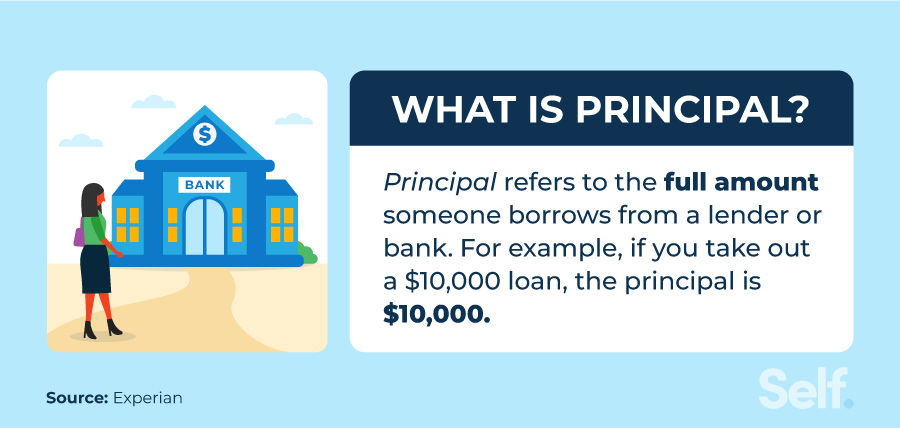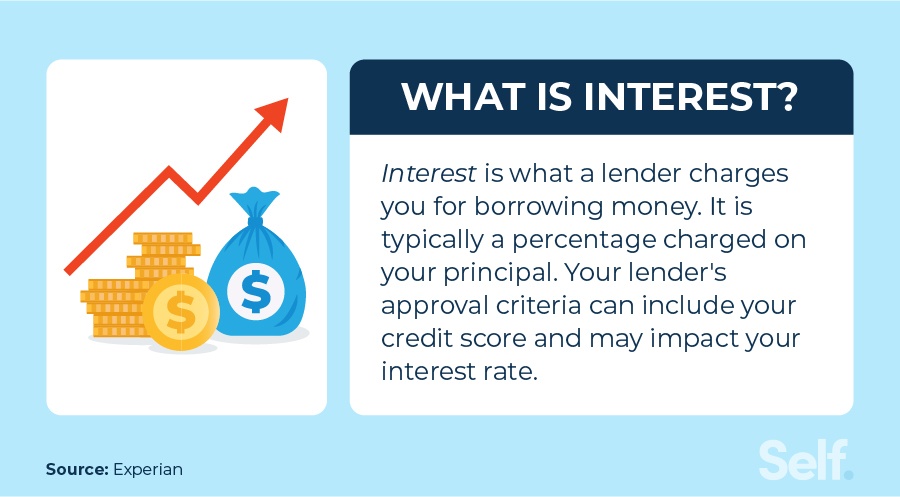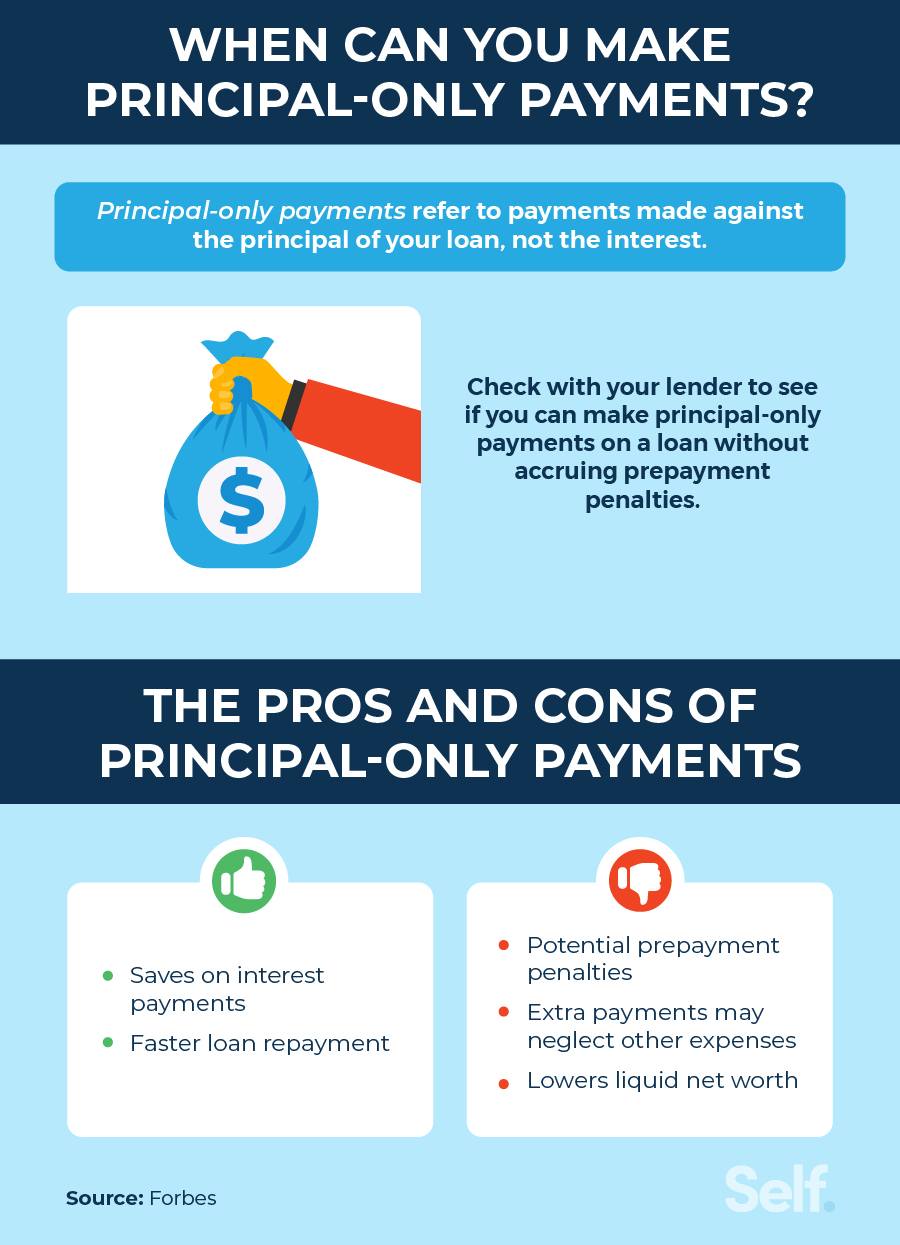Principal vs. Interest on Credit Cards and Loans
Published on: 02/10/2023
Although loans may include other fees, with most loans, principal and interest make up the two primary parts that you pay back to your lender. The principal balance is the original amount of money you borrowed, and the loan interest is what the lender charges you for borrowing the money. Paying interest and principal applies to credit and loan products, such as credit cards, personal loans, auto loans, mortgage loans and student loans. [1]
Interest adds extra costs to your original loan amount. Several factors can influence the amount of interest you get charged and must pay in addition to your principal balance, such as your credit score and credit history as well as your loan terms. The terms include items such as the annual percentage rate (APR; the total cost you are charged for borrowing money), the loan term or amount of time it takes to pay it back, whether you’re charged daily, annual or monthly interest, your monthly payment amount and your loan amount.
If you’re repaying a loan balance or outstanding credit card balance, this post explains how interest rates function, so you can focus your repayment efforts and possibly pay less interest.
What is principal?
Principal is the amount of money that you’re taking out in a loan. The principal balance excludes interest — it’s just the exact original amount of your loan. For example, if you took out a $10,000 loan, the principal would be $10,000.

What is interest?
Interest refers to what a lender charges you for borrowing money and is typically a percentage charged on your principal. Your interest rate plus any applicable fees represent your total cost to borrow, which is usually represented as a percentage called an annual percentage rate (APR).
Revolving credit, like credit cards, may charge different interest rates for different transactions like purchases or cash advances, but in terms of your APR, for credit cards your APR is your interest rate. Loans, however, factor any extra loan fees as well as the interest rate into their APRs so that loan APRs represent the true annual cost of the loan.

Interest is charged on the principal amount when you borrow money from a bank or lender. Your lender applies a portion of each loan payment to both the principal balance and the interest charged.
Interest can vary based on a variety of factors including:
- Which lender you borrow from
- Type of loan or credit you’re seeking to borrow
- Your credit score and other approval criteria
Principal and interest on loans
Loans and credit cards are different types of credit. Loans are installment accounts and credit cards are revolving accounts. They both still have principal and interest, but how you use these accounts, as well as pay them back, differs.
Understanding your amortization schedule
Typically, installment loans follow some type of amortization schedule for payments. Amortization schedules break down each loan payment and show what portions apply to principal and interest over the loan term.[2] The lender sets an amortization schedule to show you what your payment amount is monthly so that you pay the loan off within the agreed-upon term. Through amortization you make a regular monthly payment that pays down your loan over a designated time period and also includes the interest you are charged.
Your amortization schedule can help you figure out how much interest you’ll be charged over the loan term. If you’re able to pay down the principal balance faster, or make additional payments, you may be able to save on interest charges. Just be sure, if you make extra payments, that you still make your next month’s payment by the due date or you’ll be considered late.
Paying off principal and interest
Your amortization schedule defines the amount you pay over what amount of time, especially on fixed-rate loans like mortgages. You may, however, find some benefits, and some downsides, to paying off your principal faster by making larger or additional payments.
If your lender allows it, you may be able to make additional principal-only payments and designate extra payments against the principal balance. However, not every lender allows this. While some lenders may allow extra payments to be made, how extra payments are applied differs from lender to lender. With some lenders, you can designate additional payments as principal payments, but some lenders may charge penalties, such as prepayment fees, for extra payments. The next section walks you through considerations you should make before making extra payments on your loan.
Pros and cons of principal-only payments
Principal-only payments are payments that are applied only to the principal balance of a loan. Some lenders allow people to make these (and other) types of loan payments online, while others require checks to be mailed. In either case, you may need to write in on a physical check or check a box online to mark these payments as principal only.
Check with your lender to find out if principal-only payments are allowed, and you face any penalties for prepayment or shortening the loan term. Lenders dictate how or if a borrower can designate principal-only payments towards their loan, though some loans, specifically private and federal student loans, are protected from penalties by federal law.[3]

Consider the following advantages and disadvantages of making principal-only payments.
Pros:
- Saves on interest payments: Reducing the life of the loan, as well as the principal balance, can reduce the amount of interest you’d pay over time.
- Faster loan repayment: Paying down more of your principal balance than the required monthly payment means you’ll pay off the loan faster than outlined in your loan term.
Cons:
- Potential prepayment penalties: Some lenders charge a fee if you pay off all or some of your loan early, so you may be swapping interest charges for prepayment penalties. If your loan is subject to prepayment penalties, consider if the amount of interest you pay is more or less than what the penalties would be.
- Extra payments may neglect other expenses: Putting more money towards your loan payments may take away from your budget for other bills and living expenses.
- Lowers liquid assets: Spending more on monthly payments towards your loan means you may have fewer liquid, or cash, assets that you may need for emergencies.
Principal and interest on credit cards
While monthly payments for loans are usually dictated by the amortization schedule, credit cards, as revolving accounts, typically don’t follow a schedule for monthly payments. Credit card issuers also calculate the amount of interest you pay a little differently.[4]
How credit card interest works
Credit cards often have different interest rates, depending on the type of transaction — like making a purchase versus getting a cash advance — the type of credit card and the terms of your cardmember agreement.
Many credit cards calculate interest using an interest rate, based on the average daily balance. The interest rate is referred to as the “daily periodic rate.”
Most credit cards have a grace period for purchases — between the end of the billing cycle and your due date. If you pay off your credit card balance in full during this period and aren’t carrying a balance already, you may avoid interest charges for that month.
Should you pay off principal or interest first?
Credit card balances aren’t typically referred to as principal balances. You’re only charged interest if you carry a balance on your card, so you don’t have to worry about paying interest if you simply don’t carry a balance. Generally, you can avoid paying interest on a credit card by paying off the balance from purchases in full by your due date, although you may be charged interest immediately for transactions like cash advances.
If you do carry a balance, paying down your balance consistently also impacts how much interest you are charged, and revolving accounts like credit cards allow borrowers more flexibility in how and when they can pay their balance than loans do. You typically can make as many payments on your balance as you want to in a given month. Also, some credit cards have introductory offers of a 0% APR, meaning that you may not incur interest charges for certain types of transactions during that time period.
Strategies for faster debt repayment
If your lender allows it, repaying your debt faster may help not only reduce the amount of time you have debt to pay but may also save you money on potential interest charges.
These debt repayment strategies apply to both credit card and loan payments and can help you target principal and interest for any debt you have.

Make multiple payments when possible
Making multiple payments, in addition to your minimum monthly payments, can help you get out of debt faster. The more you pay down your balance, the sooner you pay back the loan.
However, consult your personal finances and monthly budget to see if you’re able to contribute more per month before committing to extra payments to avoid overextending yourself financially. Even small additional payments, or one-off payments when you have the extra cash, can help in the long run.
Pay more than your minimum payment
Paying more than your minimum payment each month can get you out of debt faster and save you from accumulating more debt overall. Even if all you can afford is a small extra amount, anything extra helps to chip away at your balance and may help you reduce the total cost of your loan or use of credit.
Use the debt snowball or debt avalanche method
Some popular ways to approach debt repayment are the debt snowball and debt avalanche methods.[5]
Debt snowball method
The debt snowball method is where you evaluate all of the credit card balances and/or installment loans you have and pay the smallest balance first, then work your way up to repaying your higher balances. If you have debt spread across multiple credit cards or need to pay down an intimidating amount of debt, using the debt snowball method can offer motivation as you tackle each balance.
The satisfaction of paying off one debt, even a fraction of your total debt, can help motivate you to keep going. And, as you pay off each balance, you have more money to put towards the next payment, creating the “snowball effect.”
Debt avalanche method
The debt avalanche method involves making bigger payments on high-interest debt first.
This repayment method may be harder to use if you struggle to remain motivated, but its long-term benefits can make it well worth it, especially if you’re dealing with high-interest credit cards that can build up interest charges fast.
Consider debt consolidation if your debts are too high
Debt consolidation loans are personal loans that consolidate high-interest debts, such as credit cards, into one loan. Debt consolidation simplifies your debt payments by giving you just one monthly payment, lumping all of your debt into one payment you can budget for each month.[6]
Consolidating your debt will not reduce the total amount you owe and may not reduce the amount of interest you’ll accumulate on that debt otherwise. However, if you’re struggling to manage your debt and qualify for a debt consolidation loan, this may be a helpful strategy in getting things back under control.
As with any choice you make for your personal finances, debt consolidation has its advantages and disadvantages.
Debt consolidation can be a good option when you fall into both of the following factors:
- You have a very good credit score: A very good credit score or excellent credit score may allow you to qualify for a loan with a lower interest rate.
- You have high-interest debts: If you qualify for a lower-interest rate loan, consolidating multiple high-interest debts into one lower-interest debt saves on the amount of interest you’d pay overall.
It may not be a good option when:
- You have bad credit: While you may qualify for a loan, you may not get the benefit of a lower interest rate, so the savings on interest charges may not be significant if at all.
- You can’t make consistent payments: If you can’t make consistent monthly payments on the loan, you may be saddling yourself with more problems by consolidating your debt.
Factor loan and credit card payments into your budget
Factoring monthly payments for your loans and credit cards into your budget is an important step toward debt repayment. If possible, budget so that you can pay your bills and have enough to take care of your other personal expenses.
If you’re looking for other ways to build your credit, you may want to consider a credit builder loan, like the Self Credit Builder Account, so that you build savings with the loan while also building credit, or look into a secured credit card, like the Self Visa® Credit Card.
Sources
- Experian. “What Is Loan Principal?” https://www.experian.com/blogs/ask-experian/what-is-principal/. Accessed August 19, 2022.
- Consumer Financial Protection Bureau. “What is negative amortization?” https://www.consumerfinance.gov/ask-cfpb/what-is-negative-amortization-en-103/#:~:text=Amortization%20means%20paying%20off%20a,goes%20down%20with%20each%20payment. Accessed January 5, 2023.
- Forbes. “Principal-Only Student Loan Payment: What To Know,” https://www.forbes.com/advisor/student-loans/principal-only-student-loan-payment/. Accessed August 19, 2022.
- Consumer Financial Protection Bureau. “How does my credit card company calculate the amount of interest I owe?” https://www.consumerfinance.gov/ask-cfpb/how-does-my-credit-card-company-calculate-the-amount-of-interest-i-owe-en-51/. Accessed August 19, 2022.
- Forbes. “Debt Snowball Vs. Debt Avalanche: The Best Way To Pay Off Credit Card Debt,” https://www.forbes.com/advisor/credit-cards/debt-snowball-vs-debt-avalanche-the-best-way-to-pay-off-credit-card-debt/. Accessed August 19, 2022.
- Experian. “Is a Debt Consolidation Loan Right For You?” https://www.experian.com/blogs/ask-experian/is-a-debt-consolidation-loan-right-for-you/. Accessed August 19, 2022.
About the author
Ana Gonzalez-Ribeiro, MBA, AFC® is an Accredited Financial Counselor® and a Bilingual Personal Finance Writer and Educator dedicated to helping populations that need financial literacy and counseling. Her informative articles have been published in various news outlets and websites including Huffington Post, Fidelity, Fox Business News, MSN and Yahoo Finance. She also founded the personal financial and motivational site www.AcetheJourney.com and translated into Spanish the book, Financial Advice for Blue Collar America by Kathryn B. Hauer, CFP. Ana teaches Spanish or English personal finance courses on behalf of the W!SE (Working In Support of Education) program has taught workshops for nonprofits in NYC.
Editorial policy
Our goal at Self is to provide readers with current and unbiased information on credit, financial health, and related topics. This content is based on research and other related articles from trusted sources. All content at Self is written by experienced contributors in the finance industry and reviewed by an accredited person(s).
